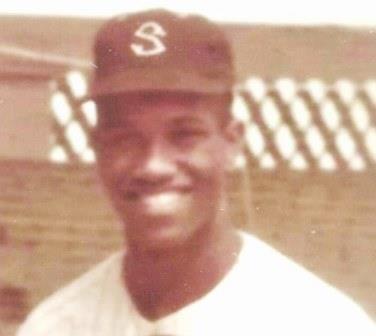From 1900-to 2021, six big-league hurlers posted at least 25 wins with 300+ strikeouts, in one season: Rube Waddell (1904), Walter Johnson (1910 and 1912), Bob Feller (1946), Sandy Koufax (1963, 1965, and 1966), Mickey Lolich (1971) and Steve Carlton (1972).
Carlton’s 1972 campaign is most impressive. His Phillies were 59-97; Carlton won 45.8 percent of their wins! In 1980, he went 24-9 for the Phillies, with 286 strikeouts and 23-11. 286 strikeouts with the 1982 Phils. Lolich had a 25-win, 300-strikeout 1971 season, with a 8.3 WAR and 2.92 ERA. Table I summarizes these 25-win, 300+ strikeout seasons.
Table I: The 25-win, 300-strikeout “Club” (1900-2021)
| Pitcher | Team | Year | W-L | ERA | K | BB | WHIP | WAR |
| Sandy Koufax | Los Angeles Dodgers | 1963 | 25-5 | 1.88 | 306 | 58 | 0.875 | 9.2 |
| “ | 1965 | 26-8 | 2.04 | 382 | 71 | 0.855 | 10.0 | |
| “ | 1966 | 27-9 | 1.73 | 317 | 77 | 0.985 | 9.1 | |
| Walter Johnson | Washington Senators | 1910 | 25-17 | 1.36 | 313 | 76 | 0.914 | 9.6 |
| “ | 1912 | 33-12 | 1.39 | 303 | 76 | 0.908 | 9.3 | |
| Steve Carlton | Philadelphia Phillies | 1972 | 27-10 | 1.97 | 310 | 87 | 0.993 | 11.1 |
| Bob Feller | Cleveland Indians | 1946 | 26-15 | 2.18 | 348 | 153 | 1.158 | 10.0 |
| Mickey Lolich | Detroit Tigers | 1971 | 25-14 | 2.92 | 308 | 92 | 1.138 | 8.3 |
| Rube Waddell | Philadelphia A;s | 1904 | 25-19 | 1.62 | 349 | 91 | 1.039 | 9.2 |
WAR: Wins above replacement; WHIP: Walks + hits per innings pitched.
Carlton fined-tuned his pitching in Puerto Rico

Carlton’s two winter seasons with 1965-66 and 1966-67 Ponce Lions, did him a “world of good,” according to his Ponce manager, Luis “Tite” Arroyo, and team owner Juan “Yuyo” González. They noted that Carlton “improved tremendously from one season to the next.”
Tite Arroyo traveled to St. Louis in August 1965 to sign imports for Ponce. He noticed a tall lefty warming up in the bullpen. It was Steve Carlton. Arroyo was intrigued by bringing Carlton to Puerto Rico. The St. Louis brass was not since he was a top prospect whom they wanted to shield from possible injuries in winter ball. Arroyo convinced St. Louis to send Carlton to Ponce and received permission to speak with the 20-year old. “Carlton frequently told me how much the Puerto Rico Winter League (PRWL) meant to him,” Arroyo recalled. “He didn’t even know how to get ready on the mound with men on base. All the runners on first got to second easily. He didn’t pivot properly. We worked on that.”
Table II showcases Ponce’s 1966-67 pitching staff. Carlton and teammate Nelson Briles tied for the league lead with five SHO. Ponce finished first after defeating Santurce in a tie-breaker but lost the league finals to them, managed by Earl Weaver. Carlton benefitted from pitching post-season contests both winters in Puerto Rico. He made it to Cooperstown in 1994.
Table II: Ponce Lions 1966-67 Pitching Stats
| Pitcher | G | GS | CG | SHO | W-L | IP | K | BB | ERA |
| Nelson. Briles | 20 | 18 | 10 | 5 | 12-3 | 144 | 88 | 40 | 2.80 |
| John Boozer | 25 | 13 | 9 | 2 | 10-7 | 129.2 | 90 | 21 | 1.80 |
| Steve Carlton | 17 | 15 | 7 | 5 | 9-5 | 116.1 | 93 | 27 | 2.09 |
| Pedro Ramos | 18 | 16 | 6 | 1 | 8-3 | 110.2 | 62 | 15 | 2.36 |
| Tito González | 12 | 7 | 2 | 1 | 6-4 | 54.1 | 24 | 17 | 2.48 |
| Félix Roque | 18 | 0-0 | 36 | 12 | 11 | 2.25 | |||
| P.J. Rivera | 6 | 1 | 0-0 | 14 | 3 | 6 | 2.57 | ||
| Horace Womack | 5 | 1 | 1 | 1 | 1-2 | 11.2 | 5 | 5 | 2.31 |
| Raúl Mercado | 3 | 1 | 0-1 | 6.2 | 2 | 2 | 4.05 | ||
| Total (9 pitchers) | 72# | 35 | 16 | 46-25 | 623.1 | 379 | 144 | 2.14 |
#One was a tie. Source:Paloviejo en los Deportes, stats by Panchicú Toste, Barceló Marqués & Co., Camuy, Puerto Rico, October 1967.
Ray Rippelmeyer, Phillies Pitching Coach and Carlton Confidante
Rippelmeyer saw Carlton throw the slider with the 1966 Tulsa Oilers, in his (Carlton’s) last minor-league season. https://www.statscrew.com/minorbaseball/stats/p-e438064d At the time, Rippelmeyer was the Phillies minor-league pitching instructor. “Carlton did not use his slider with St. Louis,” recalled Rippelmeyer. “That changed in 1972 with Philadelphia. He trusted me when I was his [1970s] Phillies pitching coach.”
Koufax’s Puerto Rico Detour
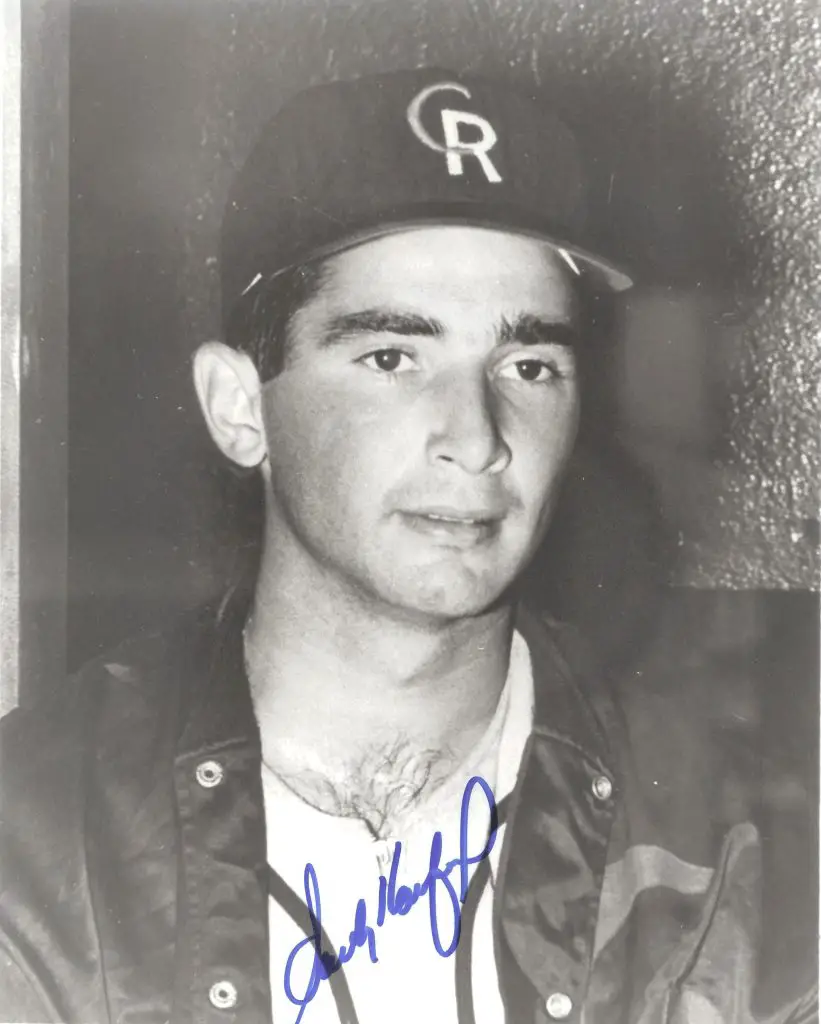
Koufax never pitched in the U.S. minors. His only pro-non-MLB pitching was with the PRWL’s 1956-57 Caguas-Rio Piedras Criollos (3-6, 4.35 ERA, 76 strikeouts in 64.2 innings, two SHO). https://beisbol101.com/limpia/sandy-koufax/ He pitched a one-hit SHO against Mayagüez, on October 31, 1956. His last Caguas game was a 2-0 SHO of Santurce, December 16, 1956, a two-hitter. Roberto Clemente got both hits. On December 20, 1956, Caguas released Koufax when a League rule went into effect, limiting teams to three experienced major leaguers on rosters, excluding natives. J.W. Porter, Mayagüez catcher, faced him one Sunday morning. Team owners were concerned about Sunday afternoon horse races’ effect on baseball attendance. One strategy was to schedule Sunday morning games. “The sun came up in the center field. Not only were you facing Sandy, but you had the big, bright ball of the sun right behind you,” Porter recalled. “You had no chance whatsoever.” Vic Power, Koufax’s Caguas teammate, recalled league pitchers of the 1950s: “[Rubén] Gómez and [Juan] Pizarro were the best native pitchers in the league’s history. Don’t forget [Lew] Burdette, [Bob] Buhl, [Bob] Turley, and Koufax.”
Koufax’s SABR bio by Marc Z. Aaron is at: https://sabr.org/bioproj/person/e463317c
From 1961 to 1966, he had five head-to-head match-ups with St. Louis’ Bob Gibson. Koufax was 3-1, 0.92 ERA, with three SHO. In 1965, he broke Rube Waddell’s single-season big-league strikeout record (349) set in 1904. Koufax, a 1972 Cooperstown Inductee, achieved:
- W-L PCT of .655, 40 shutouts, and ten 1-0 victories.
- Four no-hitters, two one-hitters, eight two-hitters, and 17 three-hitters.
- 9.28 strikeouts/nine innings and eight regular-season games with 15 or more strikeouts.
- Opponents’ batting average of .205 and 6.79 hits allowed per nine innings.
Dick Tracewski, his Dodgers roommate (1962-65), noted that Koufax was a “real gentleman, very polite, careful and not mean-spirited.” Koufax hit 18 batters in 12 NL seasons. Héctor Valle, the first catcher from Puerto Rico to play in a National League game (1965 Dodgers), mentioned his biggest big-league thrill was catching Koufax in a game at Philadelphia. “They rested Roseboro after Los Angeles had a 7-1 lead,” said Valle. “Koufax told me his Caguas experience was pleasant and good for his career. He is a very nice person.” Table III compares Koufax’s career stats to the other 25-win, 300-strikeout pitchers.
Table III: Career Regular Season Pitching Records, 25-win, 300-strikeouts club
| Pitcher | WAR | W-L | SHO | ERA | IP | H | K | BB | WHIP |
| Sandy Koufax | 48.9 | 165-87 | 40 | 2.76 | 2,324.1 | 1,754 | 2,396 | 817 | 1.106 |
| Walter Johnson | 164.8 | 417-279 | 110# | 2.17 | 5,914.1 | 4,913 | 3,509 | 1,363 | 1.061 |
| Steve Carlton | 90.2 | 329-244 | 55 | 3.22 | 5,217.2 | 4,672 | 4,136 | 1,833 | 1.247 |
| Bob Feller | 63.5 | 266-162 | 44 | 3.25 | 3,827 | 3,271 | 2,581 | 1,764 | 1.316 |
| Mickey Lolich | 48.0 | 217-191 | 41 | 3.44 | 3,638.1 | 3,366 | 2,832 | 1,099 | 1.227 |
| Rube Waddell | 58.4 | 193-143 | 50 | 2.16 | 2,961.1 | 2,460 | 2,316 | 803 | 1.102 |
#All-time post-1900 record.
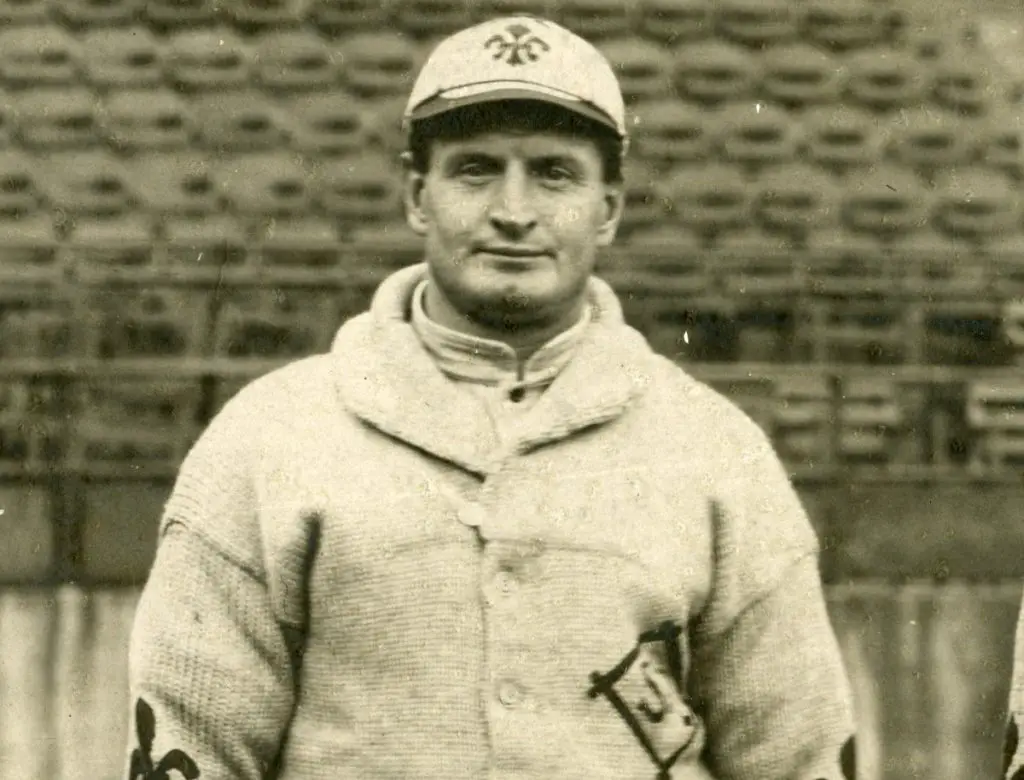
He was a Louisville Colonels (1897 and 1899) and Pittsburgh Pirates (1900-1901) teammate of Honus Wagner. Waddell led the NL with a 2.37 ERA in 1900. His best season was for the 1905 Philadelphia A’s (27-10, AL league-leading 1.48 ERA, 287 strikeouts), but he did not pitch in the 1905 World Series. Speculation includes gamblers’ questionable injury and efforts to keep him from throwing. He fanned 302 in 1903, with a 21-16 W-L mark, before 25 wins and 349 strikeouts for the 1904 A’s. His most famous game was a 20-inning CG versus Cy Young and the Boston Americans, Game Two, July 4, 1905, double-header. Erik Strohle, National Baseball Hall of Fame and Museum, detailed this game at https://baseballhall.org/discover-more/stories/short-stops/a-game-for-the-ages
In-Game One, Waddell preserved a 5-2 A’s win by getting two ninth-inning outs. He allowed two first-inning runs, in Game Two, before hurling 19 straight scoreless innings in a 4-2 victory. In the top of the 20th, Waddell hit a grounder to short, with the bases loaded, which was misplayed. The A’s got an insurance run, and Waddell finished inducing two pop-ups. He performed cartwheels around the mound to celebrate! Waddell’s 20-inning, three-hour-and-31 minute CG stats compared to Cy Young included:
- Waddell (16-4)—15 hits allowed, 79 batters faced, 11 strikeouts, and four walks
- Young (7-10)—12 hits allowed, 75 batters faced, nine strikeouts, and zero walks.
Young noted that “it was the greatest game he had ever participated and the greatest performance either of us has ever shown.” On May 8, 1904, Young bested Waddell, 3-0, with the first perfect game of the modern era. Waddell made the last out. https://www.baseball-reference.com/boxes/BOS/BOS190507042.shtml Walter Johnson, as written in the 2021 National Baseball Hall of Fame and Museum Yearbook, said: “[Waddell] had more sheer pitching ability than any man I ever saw.” Waddell was enshrined posthumously in Cooperstown (1946), the same year a historic barnstorming tour took place.
Bob Feller and 1946 Barnstorming Tour versus Satchel Paige All-Stars
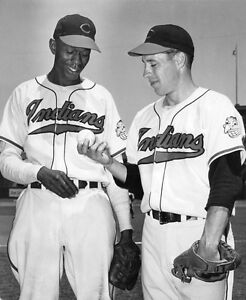
Feller, in September 1946, was within “striking distance” of Waddell’s 349 strikeouts. He frequently pitched the final month but fell short, with 348 strikeouts. His 26 wins were one more than Waddell’s 25 in 1904. Feller had other thoughts on his mind, per Bill Francis, Writing Specialist and Senior Researcher, National Baseball Hall of Fame. https://baseballhall.org/discover/feller-paige-teamed-up-for-1946-barnstorming-tour Francis superbly documented Feller’s idea/initiative and carried out an unprecedented 27-day, 32-city tour, covering 17 states and British Columbia, via two chartered airplanes.
Bob Feller All-Stars included: Bob Lemon, Mickey Vernon, Sam Chapman, Charlie Keller, Spud Chandler, Phil Rizzuto, and Stan Musial. Boston Red Sox owner Tom Yawkey gave Ted Williams $10,000, NOT TO GO. Musial joined the tour late—post-1946 World Series—and cleared $10,000, or $7,000 more than his $3,000 winners’ World Series check. https://sportscollectorsdigest.com/news/fell-paige-all-stars
At the time, big-league teams traveled by train. The Satchel Paige All-Stars comprised top Negro Leaguers, including Barney Brown, Hilton Smith, Buck O’Neil, Artie Wilson, Willard Brown, Howard Easterling, Hank Thompson, and Quincy Trouppe. There was concern that this tour posed a significant danger to all participants. Feller chartered two DC-3s for a month from Flying Tigers Airlines and claimed: “No other barnstorming tours were doing it yet, and the major league teams hadn’t started flying either. We were pioneering the practice of a pro sports team traveling that way. Today it’s hard to imagine teams going any other way.”
Joe Guzzardi’s January 26, 2020, article on this tour, at https://www.noozhawk.com/article/joe_guzzardi_bob_feller_satchel_paige_baseball_integration_20200126, noted that Monte Irvin regretfully “passed up the tour.” Irvin stated that “Paige and Feller earned a remarkable-for-the-era $100,000 each with the players receiving about $5,000.” Per Guzzardi, “Feller spared no expense. He hired a trainer, a doctor, a lawyer, and a public relations specialist.”
Bob Feller (L) and Satchel Paige (R), 1948 Cleveland Indians. Photo credit: www.findfreegraphics.com
Andrés Anglade Delannoy Meets Bob Feller
Andy Anglade, a native of Guayama, Puerto Rico, met Feller on baseball cruise trips, including one in 2006, when their photo was taken. “Feller was always super nice with my wife and me,” recalled Anglade. “He mentioned the financial success of that 1946 barnstorming tour—was very proud it turned out well for all participants.”
Guayama was a crucial piece in Satchel Paige’s baseball career; he went 19-3, with 208 strikeouts, in 205 innings, for the 1939-40 Guayama Witches, Puerto Rico League Champs. Coincidentally, the Guayama Rotary Club helped fund/administer the Guayama Witches. Per Anglade, “My uncles were Rotarians and deeply involved in the management of the baseball team. Attorney Enrique Anglade Lube was team President; engineer José Bloise Anglade was Vice-President. Two other Rotarian uncles were attorney Pedro Anglade and Luis Blondet Delannoy.”
Feller, Cooperstown Class of 1962, traveled to San Juan, Puerto Rico, to throw out the first pitch prior to the PRWL January 6, 1976, All-Star Game. Hank Aaron was the symbolic batter.
Mickey Lolich
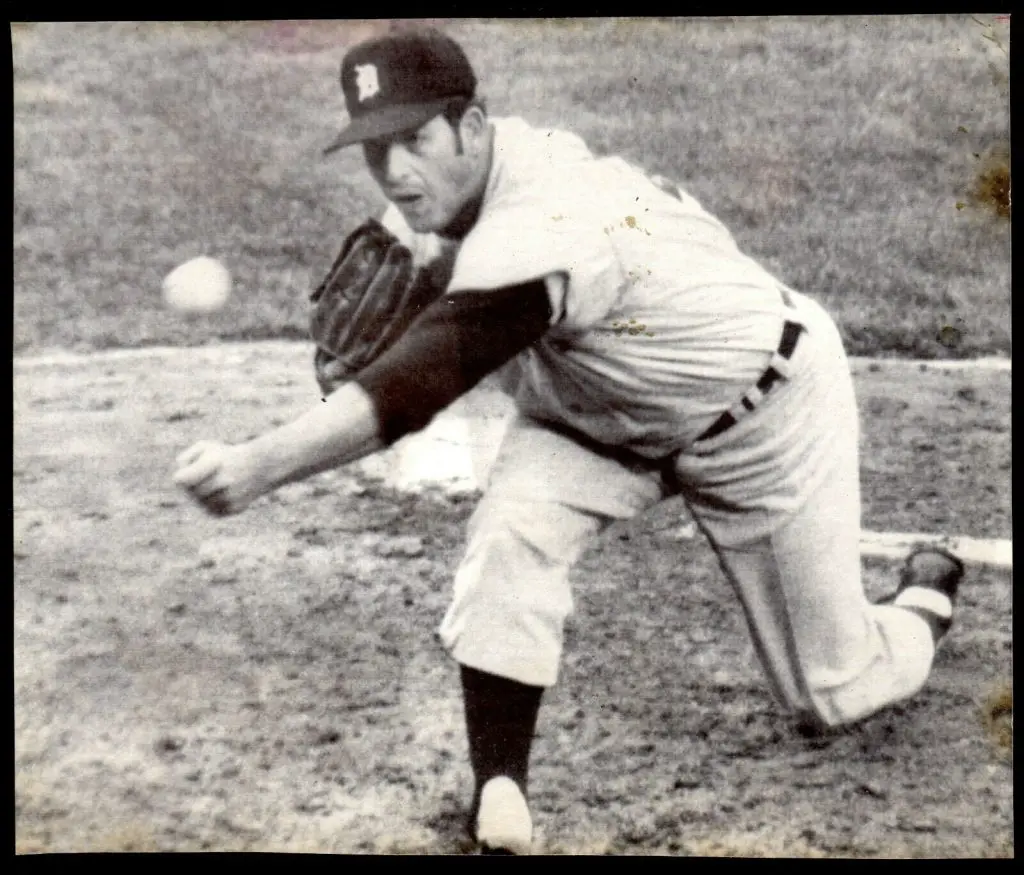
Lolich, the only hurler—of the six—not in Cooperstown, is best known for three wins, 1968 World Series versus St. Louis, with three CG. The Portland, Oregon native also pitched in the 1972 ALCS versus Oakland. He was 19-5 for Lincoln High, in Portland. The author’s father (Sam Van Hyning Jr.) moved to Portland at age seven and caught for Washington High School. (Joe Gordon, a future Cleveland Indians teammate of Feller and Paige, played for Portland’s Jefferson High against Sam.) Table IV lists the post-season pitching of five hurlers, minus Rube Waddell.
Table IV: Post-Season MLB Pitching Records, Five Pitchers
| Pitcher | TEAMS | W-L | ERA | IP | H | K | BB | WHIP | RINGS |
| Steve Carlton | STL-PHI | 6-6 | 3.26 | 99.1 | 96 | 84 | 51 | 1.48 | 2 |
| Bob Feller | CLEVELAND | 0-2 | 5.02 | 14.1 | 10 | 7 | 5 | 1.047 | 1 |
| Walter Johnson | WASHINGTON | 3-3 | 2.52 | 50 | 56 | 35 | 15 | 1.42 | 1 |
| Sandy Koufax | BLK-LAD | 4-3 | 0.95 | 57 | 36 | 61 | 11 | 0.825 | 4# |
| Mickey Lolich | DETROIT | 3-1 | 1.57 | 46 | 34 | 31 | 11 | 0.978 | 1 |
#Koufax, MVP, 1963 and 1965 World Series, did not pitch in the 1955 series, but was on Brooklyn’s roster. His other ring was with the 1959 Dodgers. Sources: baseballreference.com.
Walter Johnson

In 1907, Johnson sported a 14-2 record for a semi-pro baseball team in Weiser, Idaho, 48 miles north of Caldwell, Idaho, the birthplace of Sam Van Hyning, Jr. Johnson earned $90/week working for the Weiser telephone company and mostly pitched on weekends. The author’s paternal grandmother (Esther) was a baseball fan. She saw some of Johnson’s 1906 and 1907 semi-pro games and, according to Sam, “was at the Weiser depot, when Johnson departed on a July 22, 1907, train trip to Washington, D.C., to begin his big-league career.” The “Big Train’s” SABR bio mentioned that Johnson pitched 77 consecutive scoreless innings for Weiser in 1907, with back-to-back no-hitters. https://sabr.org/bioproj/person/walter-johnson/
During the 1910-1919 decade, he went 265-143 for Washington (.650), with teammates at 490-594 (.452). He was 36-7 with a 1.14 ERA in 1913. When the 1924 Washington Senators won their first (and only) World Series, granny Esther and Sam were ecstatic. “I was 10 when Walter Johnson won Game 7 against the New York Giants,” recalled Sam. “Dad and my sister (Virginia) were not baseball fans, but mom (Esther) and I kept up with Johnson’s pitching gems.”
Johnson was in the first group of five players inducted in Cooperstown (1936), with Ty Cobb, Christy Mathewson, Babe Ruth, and Honus Wagner. He managed the 1928 Newark Bears (International League) and pitched in one game. Johnson managed the 1929-1932 Washington Senators and 1933-1935 Cleveland Indians, winning 55 percent of the time (529-432), with five winning seasons to two losing ones. He posted a .433 batting average in 1925 when Washington won the AL pennant. In the 1930s and 1940s, Johnson saw Joshua Gibson play Negro Leagues games at Griffith Stadium. He said this of Gibson: “He can do everything. He hits the ball a mile. He catches so easy he might as well be in a rocking chair. Throws like a rifle.”
Postscript: Paul Hartzell on Nolan Ryan
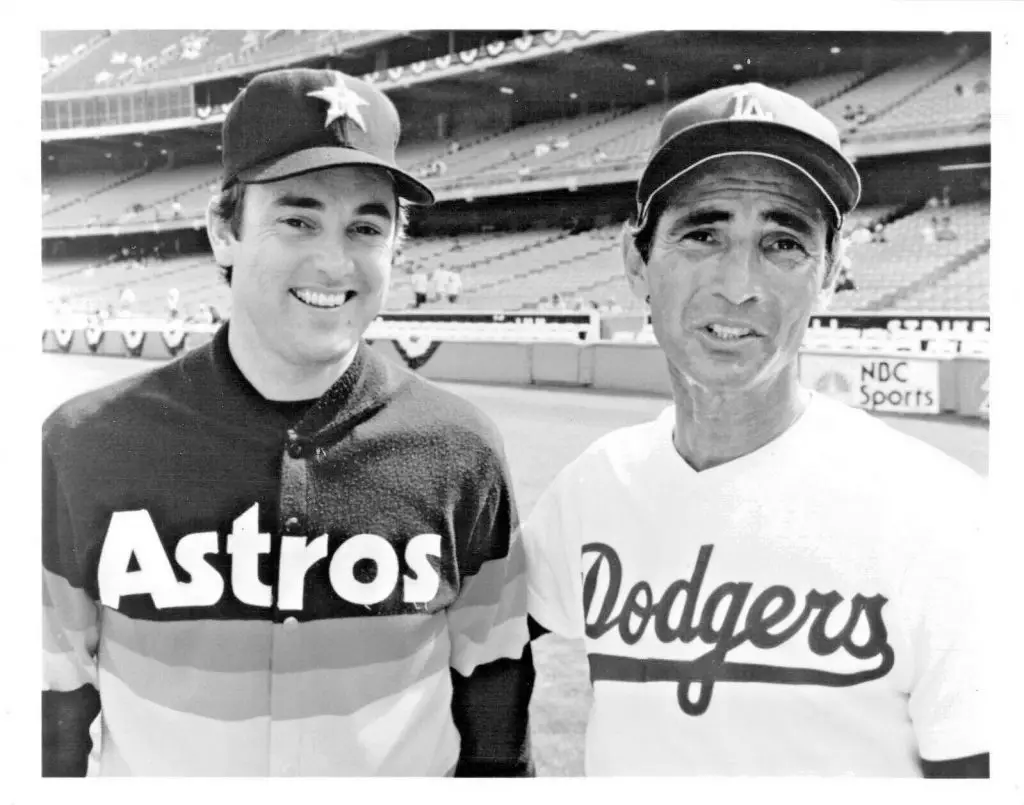
Nineteen pitchers fanned 300 or more hitters at least once, 1900-and-2021, with Randy Johnson and Nolan Ryan doing it six times, without 25+ wins. https://www.ranker.com/list/300-strikeout-season-pitchers/ranker-baseball Ryan remains MLB’s all-time strikeout king: 5,714 in 27 seasons, followed by Randy Johnson’s 4,875 K’s in 22 campaigns. Paul Hartzell, Ryan’s Angels teammate, 1976-to-1978, had a “unique perspective” on the “Ryan Express,” who previously was 21-16, with the MLB RECORD 383 K’s in 1973; followed by 22-16, 367 K’s, in 1974. Ryan’s 383 strikeouts broke Koufax’s standard of 382, set for the 1965 Los Angeles Dodgers. (Koufax’s 382 K’s remains a National League single-season record.)
“I’m pretty certain the 1976 Angels team was last or near last in runs scored in the AL,” noted Hartzell. (They were last in runs—550; HR—63; slash line: .235/.306/.318, and .624 OPS. Bobby Bonds led them with 10 HR.) “In the next three years, things improved with free agent signings. From 1976-1979, Nolan started 141 games and finished 74. He pitched 1,039 innings and struck out 1,151; gave up 743 hits and walked 649…Nolan could bring his game to a level that was truly remarkable.”
Ryan averaged 162 walks allowed/season, 1976-1979, but this dropped significantly with Houston and Texas, 1980-on. “When he got to Houston, he became a pitcher who was changing speeds, hitting spots and was truly a master of his craft…throwing the ball 100 mph or more,” said Hartzell. “Keep in mind, with Nolan and Frank Tanana (25th all-time in MLB strikeouts), every team we played would align their best pitchers against those two. And those teams knew they were in for a fight for the better part of nine innings. That means low-scoring games every time out for those two men.”
Hartzell concluded: “It was fun to watch Nolan warm-up, and I have never seen a ball thrown that hard by any other man and do it for as many innings as it took to get the job done. He never gave in to a hitter, and it was wonderful to be his teammate.”
Special thanks to Andrés Anglade Delannoy, Bill Francis, Joe Guzzardi, Paul Hartzell and Eric Strohle, Luis “Tite” Arroyo, Yuyo González, J.W. Porter, Vic Power, Ray Rippelmeyer, Dick Tracewski, Héctor Valle and Sam Van Hyning Jr. Jorge Colón Delgado. Official Historian, Roberto Clemente Professional Baseball League, did the editing-photo placement.
